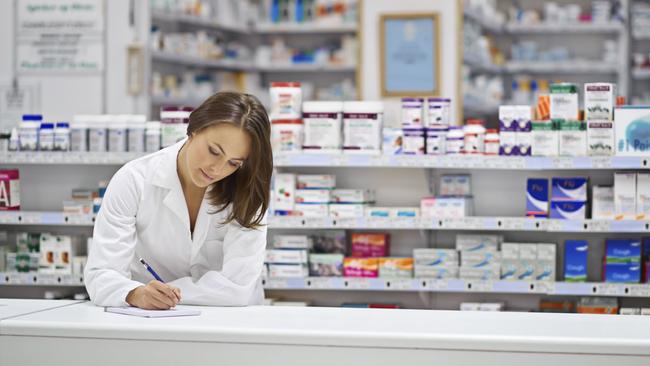Medicines shortage: Which drugs will be back in stock in 2024
Cholesterol, diabetes and blood pressure drugs are among those in short supply nationally. See list of drugs out of stock and when they’ll be back.
Health
Don't miss out on the headlines from Health. Followed categories will be added to My News.
Exclusive: Many of Australia’s most commonly used medicines are out of stock, despite the government paying drug companies millions to guarantee supply.
The deal, struck 17 months ago with big pharma, was designed to keep 900 brands of medicines on our shelves.
However, a News Corp investigation has found many brands of the drugs, including cholesterol lowering statins, antibiotics, antidepressants, reflux treatments and diabetes treatments, are in short supply.
One high blood pressure treatment, quinapril, is listed as being in “critical shortage” and is unavailable.
A spokesperson for the Department of Health and Aged Care confirmed 80 brands of medicines subject to the 4-6 month stockholding deal were currently in short supply.
They noted “in most instances where there is a current shortage, there are alternative brands containing the drug on the PBS (Pharmaceutical Benefits Scheme), which are not in shortage.”
For example, there were 10 brands of the asthma medication drug Salbutamol but only two brands were in short supply.
Irrespective, those companies that signed the deal and took the price rise have not met their obligations.

Under the strategic agreement between the former Morrison Government and generic medicine companies, the wholesale price of nearly 900 prescription medicines rose by up to 400 per cent (the average price rise was 44 per cent) on October 1, 2022.
In return, generic medicine companies promised to keep 4-6 months’ supply of the medicines in the country.
The nation’s biggest selling anti-cholesterol drugs jumped in price – Atorvastatin, from $2.95 (ex-manufacturer) to $3.45, and Rosuvastatin, from $1.70 to $2.50.
The final cost to the consumer was even higher once dispensing fees and mark ups paid to chemists were added. Taxpayers footed the bill for pensioners.
Despite the deal, a check of the TGA website revealed more than 30 of the medicines it covered were still in short supply in January, 2024.
Some brands of these treatments are not expected to be available until December this year.
The Generic and Biosimilars Medicines Association blamed the low prices Australia paid for medicines for the shortages.
“Australia is not prioritised for supply as a very small island market and a net importer (more than 90 per cent) of all our medicines,” the association said.
Two leading generic medicine suppliers – Arrotex and Viatris – have told the government the best way to solve the shortage is to provide incentives for companies to manufacture critical medicines in Australia.
This could involve raising medicine prices even further because it would be more expensive to manufacture locally.
Most of our drugs are currently imported from India and China and, once a shortage occurs, it can take six months before new supply arrives including 10 weeks to ship them here.
The industry claims the situation has improved under the policy. There were over 250 drugs priced below $4.00 at risk of “critical” shortage before it was introduced, now there are only two.

Consumer’s Health Forum chief Elizabeth Deveny said it was “deeply worrying” the pharma companies had not met their end of the deal.
“We expect the pharmaceutical industry to live up to its end of the bargain, quite frankly,” she said.
Australian Patients Association spokesman Stephen Mason said “if we’re relying solely on imports for critical, life threatening medicines and drugs, the pharma company should be encouraged or instructed to keep a minimum supply of at least four to six months on hand”.
Arrotex Pharmaceuticals said it “has met, and in many instances exceeded, its obligations”.
It was supplying two Arrotex manufactured brands – Apotex and Arrow – which meant where one brand was out of stock they bought in additional supplies of the other brand, the company said.
Generic supplier Sandoz said it “acknowledges the supply shortages of some of our products covered by the strategic agreement with the Federal Government”.
“We take this seriously and are working to rectify this as a matter of urgency,” its spokesperson said.

Pfizer said “there is a shortage in supply of‘Accuretic (quinapril hydrochloride & hydrochlorothiazide) and Accupril (quinapril hydrochloride) because of a disruption in the distribution of the medicine. This shortage in supply is unrelated to the measures outlined in the Strategic Agreement and it is not possible for those measures to prevent all medicine shortages”.
Under the strategic agreement the Health Minister can impose penalties on companies in breach of the stockholding requirements.
He can delist the medicine from the PBS or refuse to list new medicine on the PBS from the same company.
The department said it received a stockholding disclosure from all companies in December last year.
“The department is unable to disclose information regarding individual compliance cases and outcomes,” the spokesperson said.
More Coverage
Originally published as Medicines shortage: Which drugs will be back in stock in 2024




